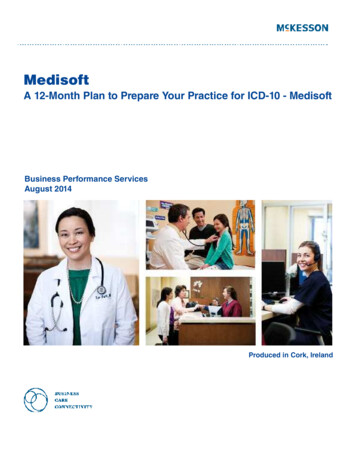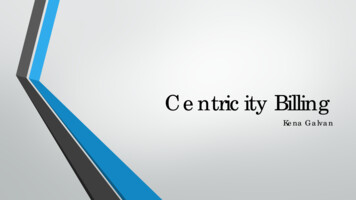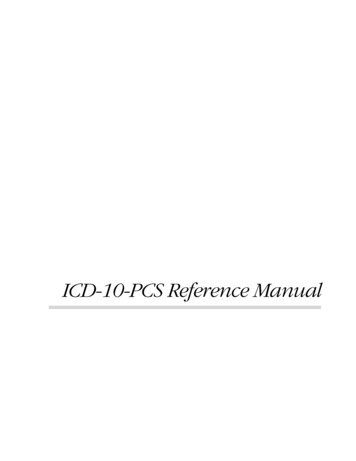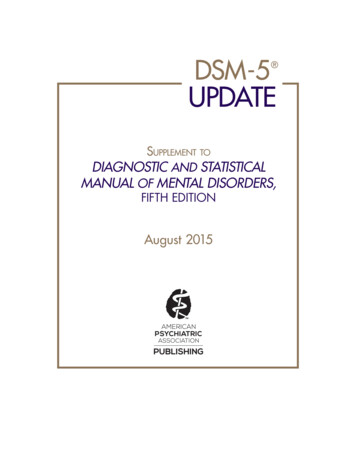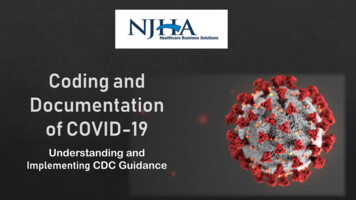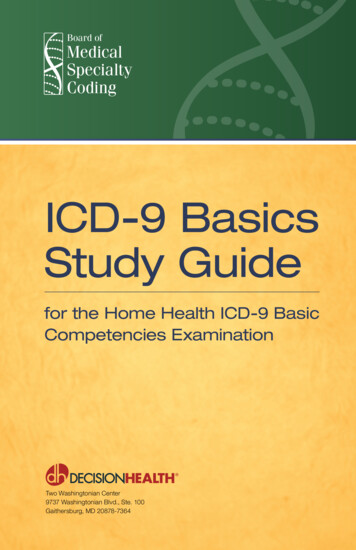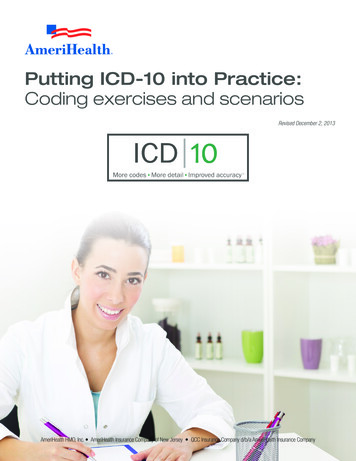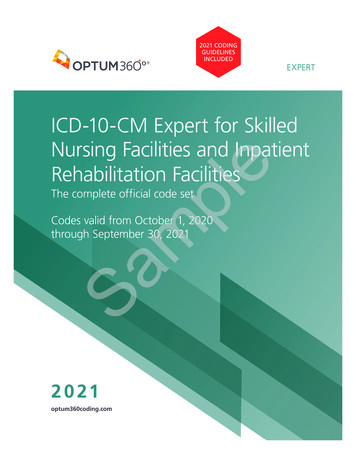
Transcription
2021 CODINGGUIDELINESINCLUDEDEXPERTeICD-10-CM Expert for SkilledNursing Facilities and InpatientRehabilitation FacilitiesmplThe complete official code setSaCodes valid from October 1, 2020through September 30, 20212 0 21optum360coding.com
ContentsPreface. iiiChapter 6.Diseases of the Nervous System (G00-G99) .563ICD-10-CM Official Preface . iiiCharacteristics of ICD-10-CM . iiiChapter 7.Diseases of the Eye and Adnexa (H00-H59) .585Chapter 8.Diseases of the Ear and Mastoid Process(H60-H95) .623How to Use ICD-10-CM Expert for Skilled Nursing Facilitiesand Inpatient Rehabilitation Facilities . ivChapter 9.Diseases of the Circulatory System (I00-I99) .635Chapter 10. Diseases of the Respiratory System (J00-J99) .683Chapter 11. Diseases of the Digestive System (K00-K95) .701Chapter 12. Diseases of the Skin and Subcutaneous Tissue(L00-L99) .725Chapter 13. Diseases of the Musculoskeletal System andConnective Tissue (M00-M99) .749Chapter 14. Diseases of the Genitourinary System(N00-N99) .843Chapter 15. Pregnancy, Childbirth and the Puerperium(O00-O9A) .863eChapter 16. Certain Conditions Originating in the PerinatalPeriod (P00-P96) .905Chapter 17. Congenital Malformations, Deformations andChromosomal Abnormalities (Q00-Q99) .919Chapter 18. Symptoms, Signs and Abnormal Clinical andLaboratory Findings, Not ElsewhereClassified (R00-R99) .941mplIntroduction . ivWhat’s New . ivConversion Table . iv10 Steps to Correct Coding . ivOfficial ICD-10-CM Guidelines for Coding and Reporting . ivIndexes. ivIndex to Diseases and Injuries . ivNeoplasm Table. vTable of Drugs and Chemicals . vExternal Causes Index . vIndex Notations . vTabular List of Diseases . viCode and Code Descriptions. viTabular Notations . viOfficial Notations . viOptum360 Notations . viiIcons . viiColor Bars . viiiChapter-Level Notations . viiiAppendixes . ixIllustrations . ixWhat’s New . xOfficial Updates . xProprietary Updates . xivSaConversion Table of ICD-10-CM Codes . xv10 Steps to Correct Coding. xviiICD-10-CM Official Guidelines forCoding and Reporting . Coding Guidelines–1ICD-10-CM Index to Diseases and Injuries . 1ICD-10-CM Neoplasm Table . 330ICD-10-CM Table of Drugs and Chemicals . 349ICD-10-CM Index to External Causes. 398ICD-10-CM Tabular List of Diseases and Injuries . 433Chapter 1.Certain Infectious and Parasitic Diseases(A00-B99) . 433Chapter 2.Neoplasms (C00-D49) . 459Chapter 3.Diseases of the Blood and Blood-formingOrgans and Certain Disorders Involving theImmune Mechanism (D50-D89) . 501Chapter 4.Endocrine, Nutritional and Metabolic Diseases(E00-E89) . 513Chapter 5.Mental, Behavioral, and NeurodevelopmentalDisorders (F01-F99) . 537ICD-10-CM 2021Chapter 19. Injury, Poisoning and Certain Other Consequencesof External Causes (S00-T88) .963Chapter 20. External Causes of Morbidity (V00-Y99). 1177Chapter 21. Factors Influencing Health Status and ContactWith Health Services (Z00-Z99) . 1239Appendixes .Appendixes–1Appendix A: Valid 3-character ICD-10-CM Codes.Appendixes–1Appendix B: Pharmacology List 2020.Appendixes–3Appendix C: Z Codes for Long-Term Drug Use withAssociated Drugs . Appendixes–20Appendix D: Z Codes Only as Principal/First-ListedDiagnosis . Appendixes–23Appendix E: Skilled Nursing Facility ProspectivePayment System Overview . Appendixes–24Appendix F: PDPM Comorbid Conditions . Appendixes–28Appendix G: PDPM Return-to-Provider Code List . Appendixes–31Appendix H: Skilled Nursing Facility ActiveDiagnosis List. Appendixes–44Appendix I: Inpatient Rehabilitation Facility ProspectivePayment System (PPS) Overview. Appendixes–45Appendix J: Rehabilitation ImpairmentCategories (RIC). Appendixes–49Appendix K: RIC Comorbid Conditions . Appendixes–54Appendix L: Coding Issues for Long-TermCare (LTC). Appendixes–62Illustrations. Illustrations–1Chapter 3. Diseases of the Blood and Blood-forming Organsand Certain Disorders Involving the ImmuneMechanism (D50–D89) .Illustrations–1Red Blood Cells . Illustrations–1White Blood Cell . Illustrations–1Platelet . Illustrations–2Coagulation . Illustrations–2Spleen Anatomical Location andExternal Structures . Illustrations–3i
ContentsChapter 11.Chapter 12.eChapter 13.Upper Respiratory System . Illustrations–27Lower Respiratory System . Illustrations–27Paranasal Sinuses . Illustrations–27Lung Segments . Illustrations–28Alveoli . Illustrations–28Diseases of the Digestive System(K00–K95) . Illustrations–29Digestive System . Illustrations–29Omentum and Mesentery . Illustrations–30Peritoneum and Retroperitoneum . Illustrations–30Diseases of the Skin and SubcutaneousTissue (L00–L99) . Illustrations–31Nail Anatomy . Illustrations–31Skin and Subcutaneous Tissue . Illustrations–31Diseases of the Musculoskeletal Systemand Connective Tissue (M00–M99) . Illustrations–32Bones and Joints . Illustrations–32Shoulder Anterior View . Illustrations–33Shoulder Posterior View . Illustrations–33Elbow Anterior View . Illustrations–33Elbow Posterior View . Illustrations–33Hand . Illustrations–33Hip Anterior View . Illustrations–34Hip Posterior View . Illustrations–34Knee Anterior View . Illustrations–34Knee Posterior View . Illustrations–34Foot . Illustrations–34Muscles. Illustrations–35Diseases of the GenitourinarySystem (N00–N99) . Illustrations–36Urinary System . Illustrations–36Male Genitourinary System . Illustrations–37Female Internal Genitalia . Illustrations–37Female Genitourinary Tract LateralView . Illustrations–37Pregnancy, Childbirth and thePuerperium (O00–O9A) .Illustrations–38Term Pregnancy – SingleGestation . Illustrations–38Twin Gestation–Dichorionic–Diamniotic (DI-DI) . Illustrations–38Twin Gestation–Monochorionic–Diamniotic (MO-DI) . Illustrations–39Twin Gestation–Monochorionic–Monoamniotic (MO-MO) . Illustrations–39Injury, Poisoning and Certain OtherConsequences of External Causes(S00-T88) .Illustrations–40Types of Fractures . Illustrations–40Salter-Harris Fracture Types . Illustrations–40SamplSpleen Interior Structures . Illustrations–3Chapter 4. Endocrine, Nutritional and MetabolicDiseases (E00–E89) . Illustrations–4Endocrine System . Illustrations–4Thyroid . Illustrations–5Thyroid and Parathyroid Glands . Illustrations–5Pancreas . Illustrations–6Anatomy of the Adrenal Gland . Illustrations–6Structure of an Ovary . Illustrations–7Testis and Associated Structures . Illustrations–7Thymus . Illustrations–8Chapter 6. Diseases of the Nervous System(G00–G99) . Illustrations–9Brain . Illustrations–9Cranial Nerves . Illustrations–9Peripheral Nervous System . Illustrations–10Spinal Cord and Spinal Nerves . Illustrations–11Nerve Cell . Illustrations–12Chapter 7. Diseases of the Eye and Adnexa(H00–H59) . Illustrations–13Eye . Illustrations–13Posterior Pole of Globe/Flow ofAqueous Humor . Illustrations–13Lacrimal System . Illustrations–14Eye Musculature . Illustrations–14Eyelid Structures . Illustrations–14Chapter 8. Diseases of the Ear and MastoidProcess (H60–H95) . Illustrations–15Ear Anatomy . Illustrations–15Chapter 9. Diseases of the CirculatorySystem (I00–I99) . Illustrations–16Anatomy of the Heart . Illustrations–16Heart Cross Section . Illustrations–16Heart Valves . Illustrations–17Heart Conduction System . Illustrations–17Coronary Arteries . Illustrations–18Arteries . Illustrations–19Veins . Illustrations–20Internal Carotid and VertebralArteries and Branches . Illustrations–21External Carotid Artery andBranches . Illustrations–21Branches of Abdominal Aorta . Illustrations–22Portal Venous Circulation . Illustrations–22Lymphatic System . Illustrations–23Axillary Lymph Nodes . Illustrations–24Lymphatic System of Headand Neck . Illustrations–24Lymphatic Capillaries . Illustrations–25Lymphatic Drainage . Illustrations–25Chapter 10. Diseases of the RespiratorySystem (J00–J99) . Illustrations–26Respiratory System . Illustrations–26iiChapter 14.Chapter 15.Chapter 19.ICD-10-CM 2021
How to Use ICD-10-CM Expert for Skilled Nursing Facilities and Inpatient Rehabilitation Facilities 2021The Neoplasm Table is arranged in alphabetic order by anatomical site.Codes are then listed in individual columns based upon the histologicalbehavior (malignant, in situ, benign, uncertain, or unspecified) of theneoplasm.Table of Drugs and ChemicalsThe Table of Drugs and Chemicals is arranged in alphabetic order by thespecific drug or chemical name. Codes are listed in individual columnsbased upon the associated intent (poisoning, adverse effect, orunderdosing).External Causes IndexThe External Causes Index is arranged in alphabetic order by main termsthat describe the cause, the intent, the place of occurrence, the activity,and the status of the patient at the time the injury occurred or healthcondition arose.Index NotationsPseudomeningocele (cerebral) (infective) (post-traumatic) G96.19postprocedural (spinal) G97.82BracketsICD-10-CM has a coding convention addressing code assignment formanifestations that occur as a result of an underlying condition. Thisconvention requires the underlying condition to be sequenced first,followed by the code or codes for the associated manifestation. In theindex, italicized codes in brackets identify manifestation codes.Polyneuropathy (peripheral) G62.9alcoholic G62.1amyloid (Portuguese) E85.1 [G63]transthyretin-related (ATTR) familial E85.1 [G63]Shaded GuidesExclusive vertical shaded guides in the Index to Diseases and Injuries andExternal Causes Index help the user easily follow the indent levels for thesubentries under a main term. Sequencing rules may apply depending onthe level of indent for separate subentries.Hemicraniacongenital malformation Q00.0continua G44.51 — see also Migraine G43.909 meaning migraine paroxysmal G44.039chronic G44.049intractable G44.041not intractable G44.049episodic G44.039intractable G44.031not intractable G44.039intractable G44.031not intractable G44.039mplWithThe word “with” or “in” should be interpreted to mean “associated with” or“due to.” The classification presumes a causal relationship between thetwo conditions linked by these terms in the index. These conditionsshould be coded as related even in the absence of providerdocumentation explicitly linking them unless the documentation clearlystates the conditions are unrelated or when another guideline specificallyrequires a documented linkage between two conditions (e.g., the sepsisguideline for “acute organ dysfunction that is not clearly associated withthe sepsis”). For conditions not specifically linked by these relational termsin the classification or when a guideline requires explicit documentationof a linkage between two conditions, provider documentation must linkthe conditions to code them as related.ParenthesesParentheses in the indexes enclose nonessential modifiers,supplementary words that may be present or absent in the statement of adisease without affecting the code.The word “with” in the index is sequenced immediately following themain term, not in alphabetical order.Dermatopolymyositis M33.90Sawithmyopathy M33.92respiratory involvement M33.91specified organ involvement NEC M33.99in neoplastic disease — see also Neoplasm D49.9 [M36.0]SeeWhen the instruction “see” follows a term in the index, it indicates thatanother term must be referenced to locate the correct code.Hematoperitoneum — see HemoperitoneumSee AlsoThe instructional note “see also” simply provides alternative terms thecoder may reference that may be useful in determining the correct codebut are not necessary to follow if the main term supplies the appropriatecode.Hematinuria — see also HemaglobinuriaFollowing ReferencesThe Index to Diseases and Injuries includes following references to assistin locating out-of-sequence codes in the tabular list. Out-of-sequencecodes contain an alphabetic character (letter) in the third- or4th-character position. These codes are placed according to theclassification rules — according to condition — not according toalphabetic or numeric sequencing rules.Carcinoma (malignant) — see also Neoplasm, by site, malignantneuroendocrine — see also Tumor, neuroendocrinehigh grade, any site C7A.1 (following C75)poorly differentiated, any site C7A.1 (following C75)Additional Character RequiredThe Index to Diseases and Injuries, Neoplasm Table, and External CausesIndex provide an icon after certain codes to signify to the user thatadditional characters are required to make the code valid. The tabular listshould be consulted for appropriate character selection.malarial B50.8Default CodesIn the index, the default code is the code listed next to the main term andrepresents the condition most commonly associated with that main term.This code may be assigned when documentation does not supportreporting a more specific code. Alternatively, it may provide anunspecified code for the condition.Fall, falling (accidental) W19 Sbuilding W20.1 SHeadache R51allergic NEC G44.89associated with sexual activity G44.82chronic daily R51ICD-10-CM 2021vHow to Use ICD-10-CM Expert for Skilled Nursing Facilities and Inpatient Rehabilitation Facilities 2021Neoplasm TableeICD-10-CM 2021
ICD-10-CM codes and descriptions are arranged numerically within thetabular list of diseases with 19 separate chapters providing codesassociated with a particular body system or nature of injury or disease.There is also a chapter providing codes for external causes of an injury orhealth conditions and finally a chapter for codes that address encounterswith healthcare facilities for circumstances other than a disease or injury.Code and Code DescriptionsICD-10-CM is an alphanumeric classification system that containscategories, subcategories, and valid codes. The first character is always aletter with any additional characters represented by either a letter ornumber. A three-character category without further subclassification isequivalent to a valid three-character code. Valid codes may be three, four,five, six, or seven characters in length, with each level of subdivision aftera three-character category representing a subcategory. The final level ofsubdivision is a valid code.BoldfaceBoldface type is used for all codes and descriptions in the tabular list.ItalicsItalicized type is used to identify manifestation codes, those codes thatshould not be reported as first-listed diagnoses.Deleted TextOfficial NotationsIncludes NotesThe word 1 appears immediately under certain categories tofurther define, clarify, or give examples of the content of a code category.Inclusion TermsLists of inclusion terms are included under certain codes. These termsindicate some of the conditions for which that code number may be used.Inclusion terms may be synonyms with the code title, or, in the case of“other specified” codes, the terms may also provide a list of variousconditions included within a classification code. The inclusion terms arenot exhaustive. The index may provide additional terms that may also beassigned to a given code.Excludes NotesICD-10-CM has two types of excludes notes. Each note has a differentdefinition for use. However, they are similar in that they both indicate thatcodes excluded from each other are independent of each other.Excludes 1An 1 note is a “pure” excludes. It means “NOT CODED HERE!” AnExcludes 1 note indicates mutually exclusive codes: two conditions thatcannot be reported together. An Excludes 1 note indicates that the codeexcluded should never be used at the same time as the code above theExcludes 1 note. An Excludes 1 is used when two conditions cannot occurtogether, such as a congenital form versus an acquired form of the samecondition.mplStrikethrough on a code and code description indicates a deletion fromthe classification for the current year.ICD-10-CM 2021eTabular List of DiseasesAn exception to the Excludes 1 definition is when the two conditions areunrelated to each other. If it is not clear whether the two conditionsGreen font is used throughout the Tabular List of Diseases to differentiate involving an Excludes 1 note are related or not, query the provider. Forthe key words that appear in similar code descriptions in a given category example, code F45.8 Other somatoform disorders, has an Excludes 1 noteor subcategory. The key word convention is used only in those categories for “sleep related teeth grinding (G47.63)” because “teeth grinding” is anin which there are multiple codes with very similar descriptions with only inclusion term under F45.8. Only one of these two codes should beassigned for teeth grinding. However, psychogenic dysmenorrhea is alsoa few words that differentiate them.an inclusion term under F45.8, and a patient could have both thisFor example, refer to the list of codes below from category H55:condition and sleep-related teeth grinding. In this case, the twoconditions are clearly unrelated to each other, so it would be appropriateb H55 Nystagmus and other irregular eye movementsto report F45.8 and G47.63 together.c H55.0 NystagmusKey d nystagmusCongenital nystagmusLatent nystagmusVisual deprivation nystagmusDissociated nystagmusOther forms of nystagmusSaHow to Use ICD-10-CM Expert for Skilled Nursing Facilities and Inpatient Rehabilitation Facilities 2021How to Use ICD-10-CM Expert for Skilled Nursing Facilities and Inpatient Rehabilitation Facilities 2021The portion of the code description that appears in green font in thetabular list helps the coder quickly identify the key terms and the correctcode. This convention is especially useful when the codes describelaterality, such as the following codes from subcategory H40.22:d H40.22 Chronic angle-closure glaucomaeeeeChronic primary angle-closure glaucomaH40.221 Chronic angle-closure glaucoma, right eyeH40.222 Chronic angle-closure glaucoma, left eyeH40.223 Chronic angle-closure glaucoma, bilateralH40.229 Chronic angle-closure glaucoma, unspecifiedeyeTabular NotationsOfficial parenthetical notes as well as Optum360’s supplementarynotations are provided at the chapter, code block, category, subcategory,and individual code level to help the user assign proper codes. Theinformation in the notation can apply to one or more codes depending onwhere the citation is placed.Excludes 2An 2 note means “NOT INCLUDED HERE.” An Excludes 2 noteindicates that although the excluded condition is not part of the conditionit is excluded from, a patient may have both conditions at the same time.Therefore, when an Excludes 2 note appears under a code, it may beacceptable to use both the code and the excluded code together ifsupported by the medical documentation.NoteThe term “NOTE” appears as an icon and precedes the instructionalinformation. These notes function as alerts to highlight codinginstructions within the text.Code First/Use additional codeThese instructional notes provide sequencing instruction. They mayappear independently of each other or to designate certainetiology/manifestation paired codes. These instructions signal the coderthat an additional code should be reported to provide a more completepicture of that diagnosis.In etiology/manifestation coding, ICD-10-CM requires the underlyingcondition to be sequenced first, followed by the manifestation. In thesesituations, codes with “In diseases classified elsewhere” in the codedescription are never permitted as a first-listed or principal diagnosis codeand must be sequenced following the underlying condition code.Code AlsoA “code also” note alerts the coder that more than one code may berequired to fully describe the condition. The sequencing depends on theviICD-10-CM 2021
ICD-10-CM 2021How to Use ICD-10-CM Expert for Skilled Nursing Facilities and Inpatient Rehabilitation Facilities 2021Appendix J: Rehabilitation Impairment Categories (RIC)This resource provides a reference of all rehabilitation impairmentcategories (RIC) and the ICD-10-CM codes associated with each RIC.mplAppendix D: Z Codes Only as Principal/First-Listed DiagnosisChapter 21, “Factors Influencing Health Status and Contact with HealthServices,” provides codes to deal with encounters for circumstances otherthan a disease or injury. Many of these codes may be reported only as theprincipal/first-listed diagnosis. This resource lists all of these codes in onetable for quick and easy reference to ensure accurate reporting.eAppendix F: PDPM Comorbid ConditionsThis resource provides a comprehensive list of the ICD-10-CM codes thatThe additional resources described below have been included asare considered comorbid conditions for the non-therapy ancillary (NTA)appendixes for this book. These resources further instruct the professionaland the speech-language pathology (SLP) components of the PDPM.coder on the appropriate application of the ICD-10-CM code set.Appendix G: PDPM Return-to-Provider Code ListAppendix A: Valid 3-character ICD-10-CM CodesThis resource provides a comprehensive list of the ICD-10-CM codes thatThe user may consult this table to confirm that no further specificity, suchare not acceptable as the primary reason for SNF care. When one of theseas the use of 4th, 5th, 6th, or 7th characters or placeholders (X), iscodes is listed as the primary diagnosis code on the minimum data setnecessary. All ICD-10-CM codes that are valid at the three-character level(MDS), the MDS should be returned to the provider to select anare listed.appropriate ICD-10-CM diagnosis code.Appendix B: Pharmacology List 2020Appendix H: Skilled Nursing Facility Active Diagnosis ListThis reference is a comprehensive but not all-inclusive list ofThis resource includes the minimum data set (MDS) data elements thatpharmacological agents used to treat acute and/or chronic conditions.capture the relevant diagnostic or surgical information needed toDrugs are listed in alphabetical order by their brand and/or generic namescalculate one or more of the components in PDPM.along with their drug action and indications for which they maycommonly be prescribed. Some drugs have also been mapped to theirAppendix I: Inpatient Rehabilitation Facility Prospective Paymentappropriate Z code for long-term drug use.System (PPS) OverviewThe inpatient rehabilitation facility prospective payment system (IRF PPS)Appendix C: Z Codes for Long-Term Drug Use with Associated Drugs provides payment rates for rehabilitation facilities providing post-acuteThis resource correlates Z codes that are used to identify currentcare for patients that require additional services to restore the patient’slong-term drug use with a list of drugs that are typically categorized toability to live and work after a disabling injury or illness. This resourcethat class of drug.summarizes the revisions to the Quality Reporting Program, changes tothe IRF-PAI instrument, IRF requirements, and the proposed changes toNote: These tables are not all-inclusive but list some of the morethe IRF PPS for FY 2019.commonly used drugs.SaAppendix E: Skilled Nursing Facility Prospective Payment SystemOverviewTo better classify residents for payment purposes and to ensure thatresidents’ care needs are addressed, Medicare has developed thePatient-Driven Payment Model (PDPM), which will replace the currentRUG-IV classification system. Payments will predominantly be based onclinical characteristics instead of service provision. This resource describesthe PDPM and its elements, as well as how this classification system willbe used within the skilled nursing facility prospective payment system(SNF PPS).ICD-10-CM 2021Appendix K: RIC Comorbid ConditionsCertain conditions when listed as a secondary diagnosis during arehabilitation admission may qualify that stay
ICD-10-CM 2021 How to Use ICD-10-CM Expert for Skilled Nursing Facilities and Inpatient Rehabilitation Facilities 2021 ICD-10-CM 2021 v How t o U se ICD-10-C M Expert f or Ski lled Nursing F acilities a nd In patient Rehabilitation F acilities 202 1 Neoplasm Table The Neoplasm Table is arranged in alphabetic order by anatomical site.
